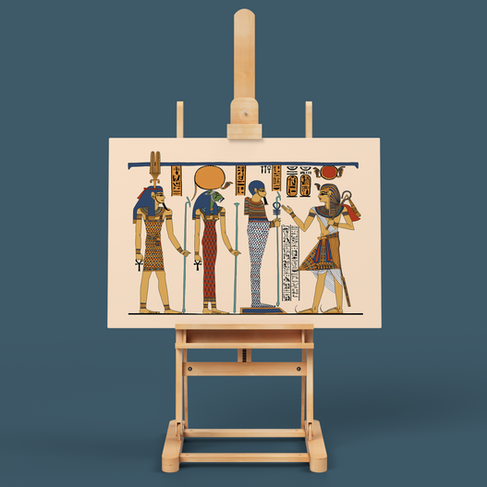The Triad of Memphis: A Glimpse of Ramesses III's Devotion to Ptah, Sekhmet, and Nefertem
- Natalie Watson
- Nov 1, 2022
- 4 min read
Updated: Jan 8, 2024
Reproduction Details
Object Type: Papyrus
Material: Papyrus
Date: c. 1150 BC
Period: Dynasty 20, Reign of Ramesses III
Findspot: Thebes, Egypt
Dimensions: H: 42.80 cm, L: 54.50 cm
Current Location: British Museum, London
Inventory Number: EA9999,43
Reproduction Number: DP79
Description
The Great Harris Papyrus is a memorial document produced following the death of Rameses III (c. 1184-1153 BC) by his son Ramesses IV. It contains a comprehensive retrospective overview of Rameses III’s reign and includes three vignettes illustrating the king’s donations to the gods and temples of Thebes, Memphis, and Heliopolis.
In this vignette, Ramesses III stands before the holy family of the ancient city of Memphis: Ptah, the patron of craftsmen, his consort the lion-headed goddess Sekhmet, and their child, Nefertum, god of the lotus. The king is shown making offerings to the resident deities, with hieratic text identifying each of the figures and recording his address to Ptah and the Memphite Triad.
Ramesses III
Ramesses is depicted wearing a sheer overskirt, linen sash, and a pleated kilt whose triangular apron has a point ending in a fox's head. He is in full regalia, wearing the royal nemes wig with a uraeus cobra on his brow, carrying the crook and flail, and sporting a stylised bull's tail. His jewellery includes a broad collar, armlets, and bracelets, and his ear is pierced for an earring.
Ramesses is identified by his two chief names given in cartouches above him:
Lord of the Two Lands, Usermaatre Meryamun (Strong is the Maat of Re, beloved of Amun) Lord of Appearances Ramessu heqa Iunu (Ramesses, ruler of Heliopolis)
He is making a gesture indicating he is speaking to the gods before him, and the two columns of hieratic record his words:
I tell the prayers, praises, adorations, laudations, mighty deeds, and benefactions, which I did for you in your presence, O Resi-inebef (South-of-His-Wall)
Ptah
Ramesses is facing Ptah, the chief deity of Memphis, who stands on a dais in the shape of the symbol Maat, the divine personification of truth, harmony and justice. Ptah is one of the oldest Egyptian gods, first mentioned in Dynasty 1 and was considered to be a creator god particularly associated with craftsmen and funerary traditions.
Ptah is shown with distinctive artistic attributes rarely seen in other gods that help identify him. He has a straight beard instead of a curved one, a tight-fitting skullcap instead of a headdress, and a counterpoise necklace with a rounded top and flared bottom. He is often depicted with elements that linked him to the god Osiris, such as the white shroud and djed-ankh symbols attached to his was-sceptre.
The hieroglyphs provide his two chief names:
Ptah the great, “South-of-His-Wall” Lord of “Life-of-the-Two-Lands”
Sekhmet
Standing behind Ptah is his consort, the lion-headed goddess Sekhmet, who is labelled in the hieratic text above her head as:
Sekhmet the great, beloved of Ptah.
As the daughter of the sun god Ra, she acted as his vengeful eye, destroyed his enemies, and brought pestilence and plague. Her solar connection is clear from the sun disk that sits atop her long wig and the uraeus cobra that encircles the headdress, which was also the emblem on the crown of the rulers of Lower Egypt. In one hand she holds an ankh, the symbol for life, and in the other a papyrus sceptre, another symbol representing Lower Egypt.
Sekhmet wears a tight-fitting, red dress with a lozenge pattern which is thought to represent a bead-net dress. The beads are cylinders of blue or green faience, which were either sewn onto a linen dress or worked into a separate net worn over the linen. In art, bead-net dresses are fairly common in the Old and Middle Kingdoms but decline in number during the New Kingdom.
Nefertem
The third member of the divine family is the holy child of the triad, who is introduced as:
Nefertem, protector of the Two Lands
In Egyptian mythology, Nefertem was originally a lotus flower that had arisen from the primordial waters at the creation of the world. He represented the creation of day with sunlight and the pleasant smell of the Egyptian blue lotus flower, associating him with perfumes aromatics.
Nefertem is usually depicted as a beautiful young man with a headdress in the shape of a lotus flower. Here his headdress is complemented by two plumes to create an atef-style crown. In one hand he holds an ankh, the symbol for life, and in the other a was-sceptre, representing power and dominion.
Translation
The text in this scene is hieratic, a handwritten adaptation of hieroglyphs for the medium of ink and brush on papyrus. Above each of the deities from left to right are their names:
Nefertem, protector of the Two Lands. Sekhmet the great, beloved of Ptah. Ptah the great, “South-of-His-Wall”, lord of “Life-of-the-Two-Lands”.
The two chief names of Ramesses III are given in cartouches:
Lord of the Two Lands, Usermaatre Meryamun (Strong is the Maat of Re, beloved of Amun). Lord of Appearances Ramessu heqa Iunu (Ramesses, ruler of Heliopolis).
Ramesses is shown presenting an address to Ptah and the holy family:
“I tell the prayers, praises, adorations, laudations, mighty deeds, and benefactions, which I did for you in your presence, O Resi-inebef (South-of-His-Wall)”.








